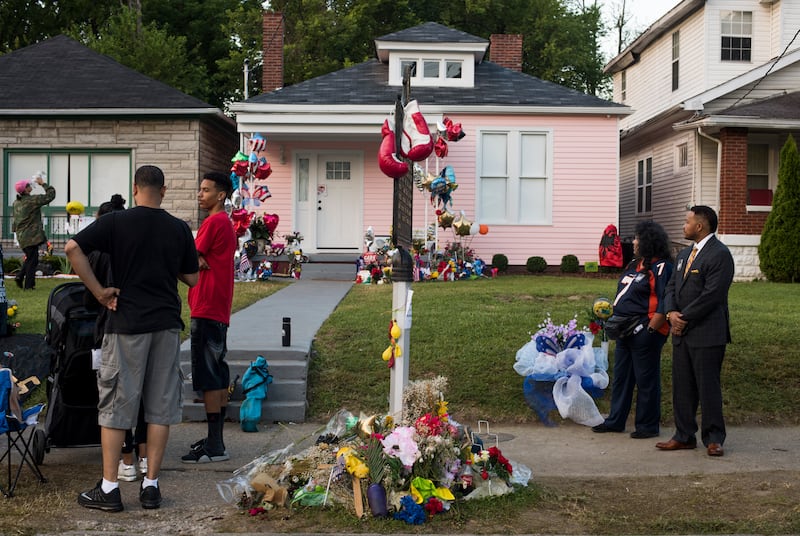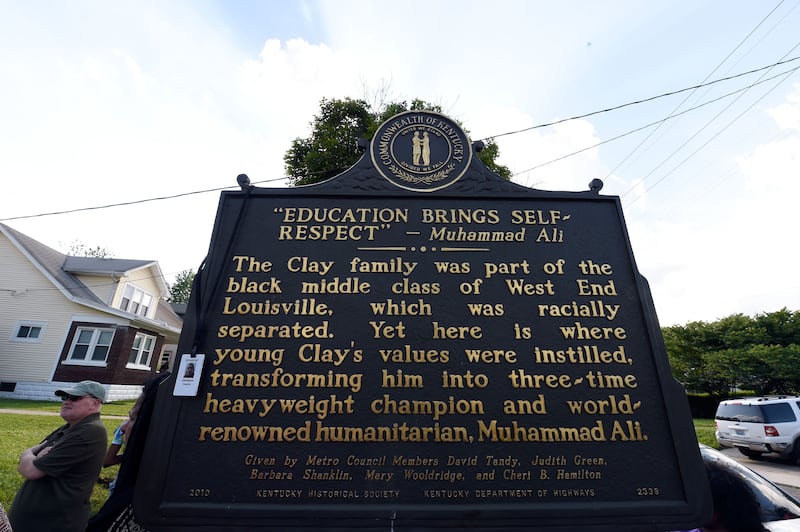Twelve months after announcing himself to the world at the 1960 Olympic Games, the fighter still known as Cassius Clay jnr was visited at his family home in Louisville by Huston Horn from Sports Illustrated. Horn was quite taken by the four-roomed clapboard bungalow where the boxer had lived from age four, a modest space from which to launch such an outsized talent. Evincing a writer’s eye for granular detail, he remarked that the ornamental frame of the front screen door at 3302 Grand Avenue had obviously been curlicued by hand with a scroll saw.
“Don’t bother your head about that stupid house,” said Clay. “One of these days they’re liable to make it a national shrine. Only by that time I’ll be long gone, man, living it up on the top of a hill in a house that cost me a hundred thousand dollars. You’ll find me out by the swimming pool, and I’ll be talking to a bunch of little boys, sitting in a circle around at my feet. ‘Boys,’ I’ll say to them. ‘I was just a poor boxer once, as I reckon you already know. Only I was a very fine boxer, one of the finest that ever lived. And right there’s how come I could move out of that little house down there on Grand Avenue and build this big one up here on the hill.’”
When he spoke that day, the steps to the front porch were still emblazoned with red, white, and blue stripes, the patriotic handiwork of his sign-painter father in preparation for his gold medal-winning son’s triumphant return from Rome the previous September. A braggadocious 19-year-old just eight fights into his professional career then, almost all his fanciful prophecy to Horn came true. If never quite a national shrine, the house is a stop on the Louisville Civil Rights Tour, and a historic marker on the footpath outside informs passersby Muhammad Ali lived at this address with his parents, Odessa and Cassius snr, and his brother Rudolph.
All of which may explain why 3302 Grand Avenue, resplendent in pastel pink, is now listed for sale by Christies with a whopping $1.5 million (€1.4 million) price tag. Quite the ask in a neighbourhood where two-bedroom, one baths of 1,200sq ft usually go for significantly less than six figures. Then again, not every house boasts a back garden where the boy who would become three-time champion of the world once cut down a prized plum tree and earned a spanking from his father.
Moral outrage over Saudi sportswashing ahead of world’s richest race has faded
Matt Doyle offered Californian glamour in a dull 1980s Ireland
What time is kick-off and what TV channel is Wales v Ireland on? All you need to know about the Six Nations clash
Dan Sheehan’s remarkable recovery continues with Irish captaincy
Or the bedroom where the mischief-maker used to torment his little brother by moving the curtains with a piece of string to convince his impressionable sibling there was a ghost on the premises.
Or the kitchen where he gorged on Wheaties cereal every morning in an effort to bulk up.

“We got into the house and the first thing I did was run through the house and into the backyard,” he said once when asked his earliest memory of the place. “And there was an apple tree there and I climbed up and my mother told me to get down, and I pulled a green apple off it and started eating, and my mother told me, ‘You’ll get the flux’. Some kinda disease you get, some people die from it.”
Originally built in 1920, Grand Avenue was, by the time the Clay family arrived in 1947, an area of still segregated Louisville that was considered “black middle class”. Not as affluent as “white middle class” but certainly more prosperous than the denizens of “Little Africa” and “Smoketown”, tougher neighbourhoods in the city that the fledgling pugilist was warned to shy away from.
Grand Avenue was the house he cycled to the Louisville Home Fair from in search of free ice cream and candy as a 12-year-old. That was the day somebody stole his red and white Schwinn and made him so angry he ended up meeting Joe Martin, the police officer and boxing coach who altered the course of his life and sports history at the Columbia Gym. It was the often-troubled house where cops answered a call one summer night because his father, a violent drunk and inveterate womaniser who often beat his wife, had stabbed his 15-year-old son in the leg.

“And they didn’t come out of no ghetto,” boasted the same Cassius Clay snr of where he raised his children. “I raised them on the best street I could afford; 3302 Grand Avenue in the West End of Louisville.”
The Clays moved out once their eldest son started to make serious coin and bought them a larger home across town on Buechel Bank Road. Having passed through several different owners across subsequent decades, Grand Avenue was vacant before George Bochetto, an attorney and former Pennsylvania boxing commissioner, was part of a group that turned it into a Muhammad Ali Museum in 2016. Even with each room expensively restored to look exactly like it was when the Clays lived there, the period piece never proved a viable box office attraction.
Long since closed, the owners are selling it and the two properties on either side as part of a package deal. An exorbitant asking price is underscored by scurrilous talk that offers have been received to relocate 3302 to, among other places, Saudi Arabia or Las Vegas. Moving this home from Louisville to either desert would be something. And definitely not grand.
















